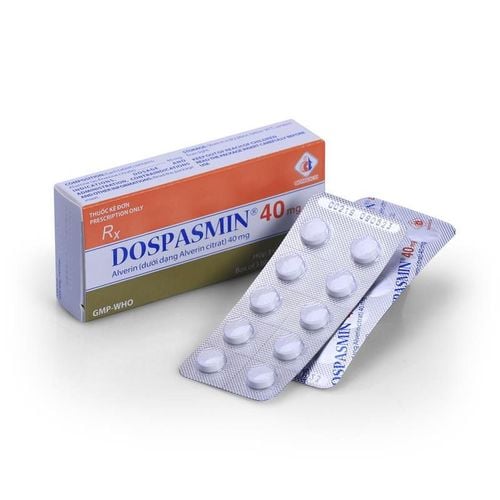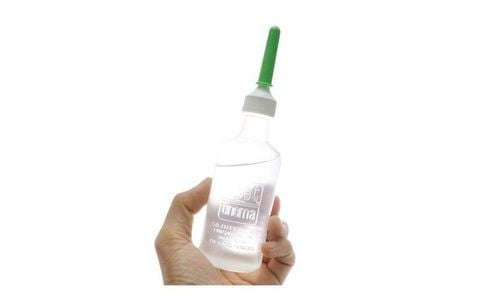This is an automatically translated article.
Alosetron is used primarily to treat and relieve symptoms of irritable bowel syndrome (IBS). During treatment with Alosetron, patients need to remember to take the medicine according to the instructions to minimize the risk of experiencing side effects.
1. What is Alosetron?
Alosetron medicine belongs to the 5-HT3 antagonist group, containing the main active ingredient is alosetron hydrochloride, used mainly to relieve the symptoms of irritable bowel syndrome IBS and bring especially high effectiveness for people experiencing The main problem must be diarrhea for at least 6 months. Alosetron is not a cure for irritable bowel syndrome (IBS) but only works to help patients relieve abdominal pain and sudden urge to have diarrhea.
According to experts, Alosetron should not be used in children because serious side effects have been reported in adults. Therefore, any patient should be especially careful when using Alosetron.
2. Uses of the drug Alosetron
Alosetron is made in the form of tablets with a strength of 0.5 or 1mg. Doctors usually prescribe Alosetron for the following conditions:
Women with diarrhea (main symptom) caused by irritable bowel syndrome. Treatment for other symptoms of IBS such as cramping, pain, and an urgent need to have a bowel movement. Treatment for people with irritable bowel syndrome (IBS) does not improve with other treatments. The active ingredient Alosetron hydrochloride in the drug is a potent and selective antagonist of 5-HT3 receptors. These receptors are present in numerous nerve cells in the intestinal tract that, when overstimulated, cause the intestines to overwork. Alosetron helps relieve diarrhea by blocking 5-HT3 receptors, so it is highly effective in controlling IBS symptoms.
2. Dosage and how to use Alosetron
2.1 Dosage of Alosetron The starting dose of alosetron: People with irritable bowel syndrome should take the starting dose of alosetron with a concentration of 0.5mg / time and 2 times / day. If constipation occurs while taking this dose, you can temporarily stop taking the drug until the symptoms are gone, then start again at 0.5mg once a day. If constipation continues to recur, the patient should stop treatment immediately.
Maintenance dose of alosetron The patient should take the alosetron maintenance dose of 0.5mg/day, twice a day (if tolerated and well controlled IBS symptoms). In cases where the patient tolerates the drug but the IBS symptoms do not improve after 4 weeks of treatment, the doctor may increase the dose to 1mg / day and 2 times / day. If the patient continues to not achieve the treatment effect of irritable bowel syndrome after 4 consecutive weeks, the patient should stop using alosetron.
2.2 How to use Alosetron In order to use Alosetron correctly, you should carefully read the instructions for use provided by your doctor before you start taking it. The drug alosetron is made in the form of tablets, so the patient needs to take the drug with water, with or without food (depending on the doctor's instructions).
Alosetron is usually taken 1-2 times a day with a dose determined specifically based on the patient's health condition as well as the patient's ability to respond to treatment. Avoid starting Alosetron in people who are constipated. In addition, patients should take Alosetron at the same time each day to avoid missing doses. Do not arbitrarily take medicine less, more or more often than prescribed by your doctor.
You can start taking Alosetron at a low dose, after 4 weeks if there are no serious side effects, you can increase the dose as recommended by your doctor. In general, A losetron only works to control IBS, not cure it. If you stop taking the medication suddenly, IBS symptoms may return within 1 to 2 weeks.
2.3 Contraindicated to use Alosetron for which case? Do not use Alosetron medicine for the following subjects:
People who are hypersensitive to the active ingredient Alosetron HCL or any other ingredients in the drug. People with constipation, chronic constipation, severe constipation or complications related to constipation. People with intestinal strictures, history of intestinal obstruction, gastrointestinal perforation/adhesion or colonic aneurysm. People with a history of ischemic colitis, thrombophlebitis, impaired intestinal blood circulation or increased blood clotting. People who have had Crohn's disease, diverticulitis, or ulcerative colitis. People with a history of severe liver failure. The patient is taking fluvoxamine concurrently.
3. Some side effects of the drug Alosetron
During the treatment of irritable bowel syndrome with Alosetron, patients may experience some of the following undesirable side effects:
Common side effects of Alosetron:
Abdominal discomfort, abdominal pain or distention. Nausea, vomiting, severe diarrhea or constipation. Gastroesophageal reflux . Stomach pain, gastroenteritis, bloating, fatigue or headache. Hemorrhoids, muscle spasms, urinary tract infections. Upper respiratory tract infection, cough, pharyngitis. Rare side effects of Alosetron:
Indigestion, ischemic colitis, gastrointestinal spasm. Tachyarrhythmias and some complications of constipation (intestinal perforation, obstruction, intestinal obstruction, colonic aneurysm, intestinal stenosis). Arrhythmia, irritability, anxiety, fatigue, hypoglycemia. Cramp. Sweating, frequent urination, urticaria or dysregulation of body temperature. *Rare side effects of Alosetron:
Arrhythmia. Hemorrhage, hypertension, laryngitis. Ear/nose/throat infection. Decreased hypothalamic or pituitary function. Imbalance of electrolytes and water in the body. Colitis, inflammation of the stomach - duodenum - intestine. Gastrointestinal obstruction. Increase blood sugar. Blood in the stool. Decreased intestinal motility. Memory impairment, daydreaming, cognitive disturbances. Cholecystitis or abnormal bilirubin levels. Genital dysfunction, infection, fungal infection, genital bleeding. Cystitis , an erratic burning or cold sensation. Taste disorder. Alopecia areata, folliculitis, acne, eczema, skin allergies, dermatitis or skin infections. When any of the side effects mentioned above occurs, the patient should stop taking Alosetron immediately. Inform your doctor if serious complications of constipation occur so that appropriate measures can be taken.
4. Some important notes when taking Alosetron
In order to help ensure the effectiveness of treatment and safety when using Alosetron, patients should note the following:
Before treating irritable bowel syndrome with Alosetron, you should inform your doctor. Know if there is a history of allergy to the active substance Alosetron HCL or to any other drug in the past. Tell your doctor your medical history, especially of problems such as constipation, bowel obstruction, ischemia, colitis, ulcerative colitis, Crohn's disease, diverticulitis, blood clots, liver,... Elderly people need to be careful when using Alosetron because the body is more sensitive to the side effects of the drug, especially constipation. Pregnant women should only take Alosetron when absolutely necessary and after having been approved by a doctor and clearly identified the benefits and risks that Alosetron brings. If you miss a dose of Alosetron, take it as soon as you remember, but avoid taking a double dose if it is almost time for your next dose.
5. What drugs interact with Alosetron?
The use and risk of side effects of Alosetron may be affected by drug interactions. Therefore, before using Alosetron, the patient needs to list the drugs being used and notify the treating doctor. Patients should not arbitrarily use, stop or adjust the dose of any drug when starting to take Alosetron.
Here are some drugs that, when taken in combination with Alosetron, can cause interactions, including:
Fluvoxamine. Apomorphine taken with Alosetron enhances the antihypertensive effect of apomorphine. azole antifungal drugs. Protease inhibitor. Drugs metabolized via N-acetyltransferase such as hydralazine, isoniazid and procainamide. Medications with the same side effects of constipation when taken with A losetron increase the risk of serious constipation complications. Other serotonin-enhancing drugs such as ecstasy or antidepressants (SNRIs or SSRIs) when taken with Alosetron may increase the risk of serotonin toxicity syndrome. Do not use tobacco while taking Alosetron because smoking can reduce the serum concentration of Alosetron. Alosetron is used primarily to treat and relieve symptoms of irritable bowel syndrome (IBS). During treatment with Alosetron, patients need to remember to take the medicine according to the instructions to minimize the risk of experiencing side effects.
Follow Vinmec International General Hospital website to get more health, nutrition and beauty information to protect the health of yourself and your loved ones in your family.
Please dial HOTLINE for more information or register for an appointment HERE. Download MyVinmec app to make appointments faster and to manage your bookings easily.
Reference source: drugs.com












